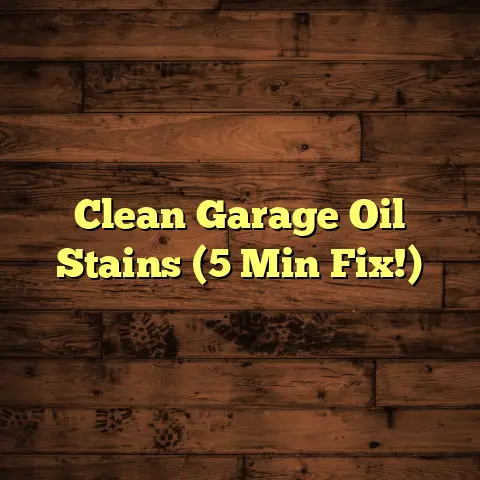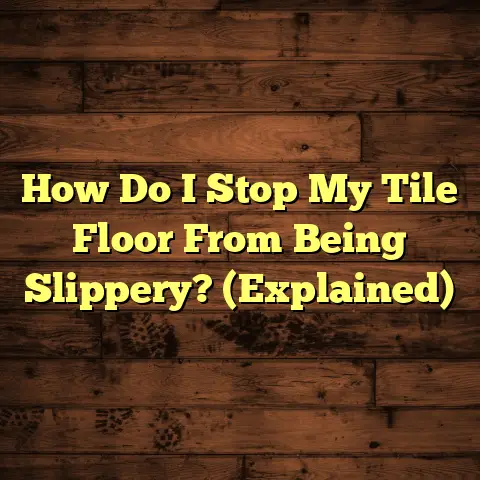How To Get Overspray Off Vinyl Floor?
Picture this: It’s a sunny Saturday morning, and you’ve decided to take on a new DIY project to refresh your living space.
The light streams through the windows, illuminating your vibrant vinyl flooring, a perfect canvas for your home.
You carefully lay down drop cloths, tape off edges, and pick out your paint colors with excitement.
As you begin spraying, you can already envision the transformation.
But suddenly, in the midst of your creative endeavor, disaster strikes—overspray lands on your beautiful vinyl floor!
Panic sets in as you realize that your hours of hard work could be overshadowed by an unsightly mess.
But fear not!
This article is here to guide you
through the process of effectively removing
overspray from vinyl flooring, restoring it
to its pristine state.
1. Introduction
Vinyl flooring has become a staple in many homes, and for good reason.
It’s durable, affordable, and comes in a dazzling array of styles.
As a flooring contractor with over 15 years in the game, I’ve seen firsthand how much people appreciate its versatility.
Maintaining the appearance of your vinyl floor
is crucial.
A clean, well-maintained floor
not only looks great but also extends the
life of the material.
One common issue I encounter is overspray.
Whether it’s from a can of spray paint,
a sealant, or even varnish, overspray can
quickly turn a beautiful floor into an eyesore.
But don’t worry, it’s usually fixable!
In this article, I’ll walk you through the steps to effectively remove overspray, so you can restore your vinyl floor to its former glory.
2. Understanding Overspray
So, what exactly is overspray?
In the context of painting and finishing, overspray refers to the fine particles of a substance (like paint or varnish) that drift away from the intended target area.
Think of it as the mist that doesn’t quite make it to the wall you’re painting.
Common culprits include:
- Spray paints (especially aerosol cans)
- Sealers
- Varnishes
- Lacquers
Why is vinyl flooring particularly vulnerable?
Well, vinyl is a non-porous material, which means it doesn’t absorb liquids easily.
This is generally a good thing, as it makes vinyl resistant to stains.
However, it also means that overspray tends to sit on the surface, making it more visible and sometimes harder to remove than from a porous surface like wood.
3. Assessing the Damage
Alright, let’s get down to business.
The first step is to figure out what kind of overspray you’re dealing with.
Is it water-based or oil-based?
- Water-based: This type is usually easier to
clean up.
If you can wipe it away with a wet cloth, you’re likely dealing with water-based overspray. - Oil-based: This is more stubborn.
It will feel sticky or tacky and won’t come off easily with just water.
Next, evaluate the extent of the damage.
Is it just a few specks, or is it a widespread
issue?
This will determine how much time and
effort you’ll need to invest.
Before you start cleaning, it’s important to take some safety precautions:
- Ventilation: Open windows or use a fan to ensure good airflow, especially when working with solvents.
- Gloves: Protect your hands from harsh chemicals.
- Eye protection: Safety glasses or goggles are a must, especially when using spray cleaners or solvents.
4. Gathering Necessary Supplies
Now, let’s gather your arsenal.
Here’s a list of supplies you’ll likely need:
- Cleaning cloths: Microfiber cloths are ideal.
- Soft-bristled brush: An old toothbrush works great for small areas.
- Plastic scraper: Avoid metal scrapers, as they can scratch the vinyl.
- Solvents:
- For water-based overspray: Warm water, dish soap, white vinegar, baking soda.
- For oil-based overspray: Mineral spirits, acetone (use with extreme caution!).
- Commercial cleaners:
- Consider a dedicated vinyl floor cleaner or a multi-purpose cleaner.
- Spray bottle: For applying cleaning solutions.
- Bucket: For rinsing water.
I always recommend testing any cleaning solution in an inconspicuous area first.
This will ensure that it doesn’t damage or discolor your vinyl floor.
Trust me, I’ve seen too many DIY projects go wrong because someone skipped this step.
5. Step-by-Step Guide to Remove Overspray
Okay, let’s get to the nitty-gritty.
I’ll break down the process for both water-based and oil-based overspray.
Removing Water-Based Overspray
- Prepare the area: Clear the area of any furniture or obstacles.
- Gather supplies: Have your cleaning cloths, soap, water, vinegar, and baking soda ready.
-
Initial cleaning: Mix a few drops of dish soap with warm water in a bucket.
- Using a soft cloth, gently wipe the affected area.
- Rinse with clean water and dry thoroughly.
Stubborn spots: If the overspray persists, try one of these methods:
- Vinegar: Mix equal parts white vinegar
and water in a spray bottle.
Spray the affected area, let it sit for a few minutes, then wipe clean. - Baking soda: Make a paste of baking soda
and water.
Apply the paste to the overspray, let it sit for a few minutes, then gently scrub with a soft-bristled brush.
Rinse thoroughly.
- Vinegar: Mix equal parts white vinegar
and water in a spray bottle.
Removing Oil-Based Overspray
This requires a bit more elbow grease and caution.
Identify the appropriate solvent: Mineral spirits is usually a good starting point.
For more stubborn cases, you might need to use acetone, but be extremely careful, as it can damage some types of vinyl.-
Application techniques:
- Dip a clean cloth into the solvent.
- Gently blot the overspray, working in small sections.
- Avoid rubbing vigorously, as this can spread the overspray or damage the vinyl.
-
Rinsing and drying: Once you’ve removed the overspray, it’s crucial to rinse the area thoroughly with clean water.
- Dry with a clean cloth.
- Repeat if necessary.
Important Note: Always work in a well-ventilated
area when using solvents.
Wear gloves and eye
protection.
6. Advanced Techniques for Stubborn Overspray
Sometimes, the overspray just won’t budge.
In these cases, you might need to bring out the big guns.
- Commercial paint removers: These are
powerful chemicals and should be used as a last
resort.
Always follow the manufacturer’s instructions carefully.
Test in an inconspicuous area first. - Heat: Applying heat can soften the overspray,
making it easier to remove.
- Use a hairdryer on a low setting to gently warm the affected area.
- Be careful not to overheat the vinyl, as this can cause damage.
- Plastic scraper or razor blade: Use these
tools with extreme caution.
- Hold the scraper at a very shallow angle.
- Gently scrape the overspray away, being careful not to gouge or scratch the vinyl.
- I often wrap the blade in tape leaving a small tip exposed as an extra precaution.
7. Preventing Future Overspray Incidents
Prevention is always better than cure, right?
Here are some tips to avoid future overspray disasters:
- Use drop cloths: Cover as much of the
surrounding area as possible with drop cloths.
Canvas drop cloths are more durable than plastic ones. - Tape effectively: Use painter’s tape to
mask off areas you don’t want to be painted.
Make sure the tape is securely attached to the floor. - Choose the right flooring: If you’re planning on doing a lot of crafting or painting, consider installing flooring that’s more resistant to stains and spills, such as epoxy or sealed concrete.
8. Maintaining Your Vinyl Floor Post-Cleanup
Once you’ve successfully removed the overspray, it’s important to maintain your vinyl floor to keep it looking its best.
- Regular cleaning: Sweep or vacuum your vinyl
floor regularly to remove dirt and debris.
Mop with a mild detergent and water. - Recommended cleaning products: Use a dedicated vinyl floor cleaner or a multi-purpose cleaner that’s safe for vinyl.
- Restore shine: To restore shine to your vinyl
floor, use a vinyl floor polish or wax.
Follow the manufacturer’s instructions carefully. - Periodic deep cleaning: Deep clean your vinyl floor every few months to remove built-up dirt and grime.
9. Conclusion
Removing overspray from vinyl flooring can be a challenging task, but it’s definitely achievable with the right knowledge and tools.
Remember, the key is to identify the type of overspray, gather the necessary supplies, and follow the steps carefully.
Don’t be afraid to experiment with different cleaning solutions, but always test in an inconspicuous area first.
And most importantly, don’t give up!
With a little patience and elbow grease, you can restore your vinyl floor to its pristine state and take on future DIY projects fearlessly.
Now, go forth and conquer that overspray!





